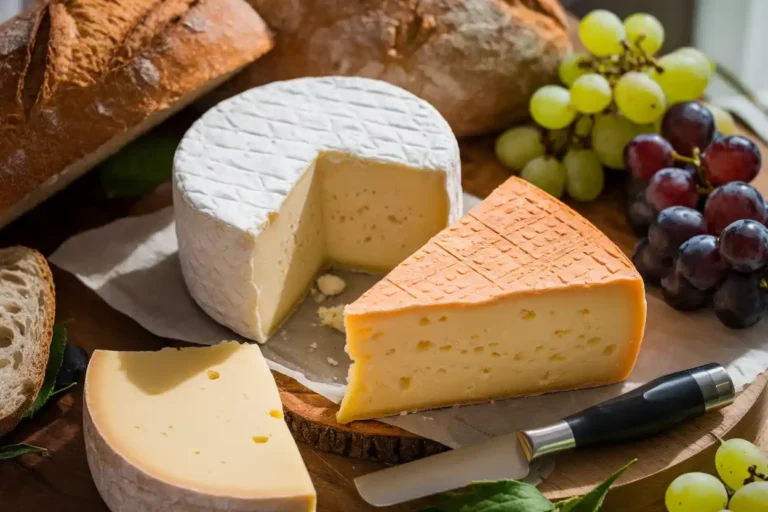When it comes to cheese, few questions spark curiosity like What is the difference between Fontina and Gruyère cheese? These two iconic varieties often find their way into gourmet recipes, each lending its unique character to dishes. While they may seem similar at first glance, Fontina and Gruyère differ significantly in flavor, texture, origin, and culinary applications.
In this article, we’ll take a deep dive into these celebrated cheeses. From their fascinating histories and production processes to their distinct taste profiles and nutritional benefits, this guide will help you understand the nuances that set them apart. Whether you’re a home cook, a foodie, or a cheese connoisseur, by the end, you’ll know exactly which one suits your next recipe. Let’s dig in!
Table of Contents
Introduction to Fontina and Gruyère Cheese
The Importance of Choosing the Right Cheese
Choosing the right cheese isn’t just about flavor; it’s about texture, meltability, and how it complements other ingredients. Fontina and Gruyère, for example, are prized for their versatility, but they shine in very different ways. Whether you’re whipping up a creamy fondue or crafting a perfectly gooey sandwich, understanding these cheeses’ unique traits can make all the difference.
Brief Overview of Fontina Cheese
Fontina cheese traces its roots back to the Aosta Valley in northern Italy, where it has been a staple since the 12th century. This semi-soft cheese boasts a mild yet earthy flavor profile with hints of butter and nuts. As it ages, Fontina develops a firmer texture and a more pronounced taste. Its creamy, meltable nature makes it a popular choice for fondues, pasta dishes, and sauces.
Modern variations of Fontina, including Danish and American types, are softer and milder, offering versatility for everyday cooking. However, traditional Italian Fontina, with its distinct rustic aroma, remains a favorite among purists.
Brief Overview of Gruyère Cheese
Gruyère cheese hails from Switzerland and takes its name from the town of Gruyères. Known for its firm texture and complex flavor, Gruyère is a hard cheese with a nutty, slightly sweet profile that deepens as it ages. Unlike Fontina, Gruyère is celebrated for its ability to hold structure when melted, making it a go-to for gratins, French onion soup, and gourmet sandwiches.
With a history dating back to the 12th century, Gruyère has become a symbol of Swiss cheesemaking excellence. It is carefully aged for months or even years to achieve its signature depth of flavor, a hallmark of authentic Alpine cheese.
Origins and History of Fontina and Gruyère Cheese
Where Does Fontina Cheese Come From?
Fontina cheese, with its rich heritage, originates from the Aosta Valley in northern Italy, a region renowned for its dairy traditions. This cheese has been crafted since at least the 12th century, making it a staple of Italian cuisine. The term “Fontina” is thought to derive from the region’s pastures, known as “Fontin,” highlighting its agricultural roots. Traditionally, Italian Fontina is made from raw cow’s milk, which contributes to its distinct earthy and creamy flavor.
Over time, other countries, including the United States, Denmark, and Sweden, have produced their versions of Fontina. These adaptations often feature a milder flavor and softer texture than their Italian counterpart. Despite these differences, authentic Italian Fontina remains a favorite for its bold, rustic notes and unmistakable aroma.
The Swiss Origins of Gruyère Cheese
Gruyère cheese takes its name from the Swiss town of Gruyères, where it has been a culinary icon since the 12th century. Like Fontina, it is deeply rooted in tradition and reflects the Alpine landscape that nurtures the cows providing its milk. Officially recognized as a product of protected designation of origin (PDO) in Switzerland, Gruyère must adhere to strict production standards to bear its name.
Swiss cheesemakers age Gruyère for months, sometimes years, to develop its signature nutty and slightly sweet flavor. The aging process also gives the cheese its firm yet pliable texture, making it versatile for cooking or snacking. Gruyère has gained global acclaim, consistently celebrated as one of the finest cheeses worldwide.
Cultural Significance and Regional Variations
Both Fontina and Gruyère carry immense cultural importance in their respective regions. Fontina represents the heart of Italian alpine cheesemaking, often paired with regional wines and dishes. Gruyère, on the other hand, is integral to Swiss culinary traditions, famously featured in fondues and raclette. Modern variations have adapted to global tastes, but both cheeses remain deeply tied to their roots.
Production Processes of Fontina and Gruyère Cheese
How Fontina Cheese is Made
Traditional Fontina production begins with raw, unpasteurized cow’s milk, which is heated gently to preserve its natural flavors. After coagulation, cheesemakers cut the curd into small pieces, drain it, and mold it into wheels. These wheels are then salted and aged in humid caves, where they develop their distinctive pungent aroma and creamy texture.
Authentic Fontina is marked by its pale yellow color, small holes, and slightly waxy rind. The aging process, typically lasting about three months, enhances its buttery flavor while introducing subtle nutty and woody undertones.
The Gruyère Cheese-Making Process
Gruyère cheese follows a similarly meticulous process. Cheesemakers use fresh, raw cow’s milk, heated and curdled with rennet. The curds are pressed into large molds and submerged in a brine bath, which enhances the cheese’s natural flavor. Aging is key to Gruyère’s character; it typically ages between 5 and 12 months in climate-controlled cellars, where the wheels are brushed with saltwater to foster the formation of their hard, golden rind.
As it matures, Gruyère develops its complex nutty and slightly sweet profile. Older Gruyère, sometimes referred to as “reserve,” is prized for its robust flavor and crumbly texture.
Key Differences in Aging and Curing
The aging and curing processes of Fontina and Gruyère highlight their unique identities. Fontina undergoes shorter aging in higher humidity, resulting in a softer, creamier cheese ideal for melting. Gruyère, aged longer in drier conditions, becomes firmer and gains a more intense flavor, making it versatile for both cooking and serving on cheese boards.
Both cheeses showcase the artisanal techniques passed down through generations, but their differences lie in the details, which define their distinct roles in the culinary world.
Flavor Profiles and Textures Compared

What is the Flavor of Fontina Cheese?
Fontina cheese offers a mild yet distinct flavor that varies with its age. Young Fontina is known for its creamy and buttery taste, with subtle nutty undertones. As it ages, the flavor becomes more robust, gaining earthy and tangy notes. Authentic Italian Fontina, particularly from the Aosta Valley, carries a slightly pungent aroma that reflects its traditional production process.
Its smooth and semi-soft texture makes it a favorite for melting. Whether used in sauces or as a gooey addition to pizza, Fontina’s flavor enhances without overwhelming the dish.
Gruyère Cheese’s Distinctive Nutty and Sweet Notes
Gruyère cheese is celebrated for its complex and harmonious flavor profile. Younger Gruyère has a creamy, nutty, and slightly fruity taste, while aged Gruyère develops deeper, earthier notes with a hint of saltiness. This balance of sweet and savory makes it an exceptional choice for both cooking and snacking.
Unlike Fontina, Gruyère’s firmer texture and slow meltability add a unique character to dishes like French onion soup and gratins. Its dense, slightly crumbly consistency allows it to shine on charcuterie boards or as a topping for casseroles.
Texture Differences Between Fontina and Gruyère
The textural differences between Fontina and Gruyère are key to understanding what sets these cheeses apart. Fontina’s soft, pliable texture melts effortlessly, making it perfect for fondues and creamy sauces. Gruyère, on the other hand, offers a firmer bite and a slower melt, ideal for dishes requiring a rich, golden crust.
Culinary Uses of Fontina and Gruyère Cheese
Classic Dishes Featuring Fontina Cheese
Fontina cheese excels in recipes that require a creamy, meltable cheese. It is often used in:
- Fondue: A rich, velvety blend of melted cheese, wine, and spices.
- Risotto and Pasta: Adds creaminess and depth without overpowering the dish.
- Stuffed Dishes: Perfect for stuffing into chicken or vegetables due to its mild flavor and gooey texture.
Signature Recipes with Gruyère Cheese
Gruyère’s versatility shines in:
- French Onion Soup: Its slow meltability and nutty flavor create the perfect golden topping.
- Croque Monsieur and Grilled Cheese Sandwiches: Adds a gourmet touch with its slightly sweet and savory notes.
- Potato Gratin: Enhances the dish with its firm yet creamy texture when melted.
Fontina vs. Gruyère: Best Substitutions in Recipes
Understanding what is the difference between Fontina and Gruyère cheese? is crucial when considering substitutions. Fontina can replace Gruyère in recipes requiring a creamy melt, such as fondues or sauces. Conversely, Gruyère is better for dishes needing a firmer, golden-brown crust, like quiches or casseroles.
Both cheeses offer unique qualities, so choosing the right one depends on the dish’s requirements. For more ideas, check out our guide to best cheeses for spaghetti.

Nutritional Differences and Dietary Considerations
Nutritional Breakdown of Fontina Cheese
Fontina cheese offers a balanced mix of nutrients, making it a tasty yet wholesome addition to meals. A typical serving (1 ounce) of Fontina provides about 120 calories, with approximately 9 grams of fat, including saturated fats. It’s also a good source of protein, offering 7 grams per serving, which makes it ideal for maintaining energy throughout the day.
Fontina is rich in calcium and vitamin A, contributing to bone health and immune support. However, it contains lactose, so it may not be suitable for individuals with severe lactose intolerance.
Nutritional Breakdown of Gruyère Cheese
Gruyère cheese is slightly higher in calories and fats compared to Fontina, with about 140 calories and 11 grams of fat per ounce. Its 8 grams of protein per serving make it an excellent source of muscle-repairing nutrients.
In addition to being high in calcium, Gruyère also provides significant amounts of phosphorus and vitamin B12, which are essential for maintaining nerve and brain health. Like Fontina, it contains lactose but in lower amounts, making it a more tolerable choice for some lactose-intolerant individuals.
Dietary Considerations: Lactose-Free and Vegetarian Options
When considering what is the difference between Fontina and Gruyère cheese from a dietary perspective, it’s essential to note their variations in lactose content. Gruyère, being aged, has a lower lactose content, making it a better option for those with lactose sensitivities.
For vegetarians, ensure the cheese uses microbial or vegetarian rennet during production. Always check product labels to confirm.
Price and Availability
Is Fontina Cheese Widely Available?
Fontina cheese is relatively easy to find, especially in supermarkets that carry a variety of cheeses. Authentic Italian Fontina, however, is often pricier due to its PDO status and import costs. Domestic varieties, like those from the U.S. or Denmark, are more affordable but lack the robust flavor of traditional Fontina.
Gruyère Cheese Availability and Cost
Gruyère cheese is similarly accessible, particularly in specialty food stores and larger grocery chains. Its price tends to vary based on its aging and origin. Aged Gruyère, also labeled as “reserve,” is more expensive but worth the splurge for its complex flavor.
Where to Find Authentic Varieties of Both Cheeses
Both cheeses are available online from gourmet retailers, making it easy to source authentic options. Local specialty shops or farmers’ markets might also carry high-quality varieties.
Part 8: FAQs About Fontina and Gruyère Cheese
What Can You Use in Place of Fontina Cheese?
If you can’t find Fontina cheese, there are several substitutes that work well depending on the recipe. Provolone, with its mild flavor and excellent meltability, is one of the best options. Mozzarella or Havarti can also step in for dishes requiring a creamy texture. For an aged alternative, Gouda offers a slightly nutty flavor similar to mature Fontina.
Considering what is the difference between Fontina and Gruyère cheese, it’s essential to match the substitute’s characteristics with the dish’s needs, particularly in recipes like fondues or sauces.
What is the Flavor of Fontina Cheese?
Fontina cheese has a mild, buttery flavor with nutty undertones. Its creamy and smooth texture makes it a popular choice for melting. Younger Fontina tastes mild and slightly sweet, while aged varieties develop a deeper, more earthy profile.
Is Fontina the Same as Provolone?
No, Fontina and Provolone are distinct cheeses with different origins and characteristics. Fontina, from Italy’s Aosta Valley, has a creamy texture and a subtle, nutty flavor. Provolone, also Italian, is semi-hard with a sharper taste, especially in aged forms.
Can Gruyère Cheese Be Substituted for Fontina?
Yes, Gruyère can substitute for Fontina in recipes, especially where a firmer texture or nuttier flavor is acceptable. However, Gruyère has a slightly sweeter profile and is less creamy when melted. When deciding between these cheeses, it helps to ask, what is the difference between Fontina and Gruyère cheese?
Conclusion
Summary of Key Differences Between Fontina and Gruyère Cheese
When comparing Fontina and Gruyère cheese, several key differences stand out. Fontina boasts a creamy, mild flavor with a buttery texture, making it perfect for melting into sauces or fondues. Gruyère, on the other hand, is firmer with a nutty and slightly sweet profile, ideal for gratins, soups, and gourmet sandwiches. Their origins Fontina from Italy and Gruyère from Switzerland further highlight their unique qualities.
Which Cheese to Choose for Your Needs?
Ultimately, the choice between Fontina and Gruyère depends on your recipe and flavor preferences. If you’re crafting a creamy pasta dish or looking for a soft, meltable cheese, Fontina is your go-to. For recipes requiring a firmer texture or a golden crust, Gruyère’s robust character is unbeatable.
Now that you know what is the difference between Fontina and Gruyère cheese, you can confidently incorporate these delicious cheeses into your cooking. Ready to experiment? Check out some creative recipes to elevate your culinary skills with these gourmet options.

